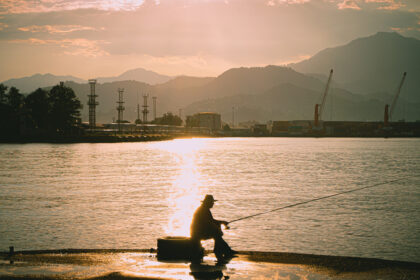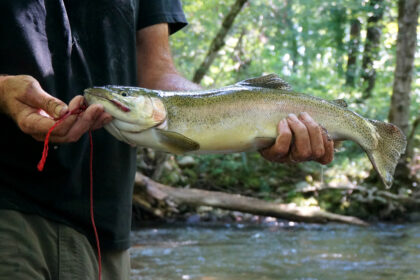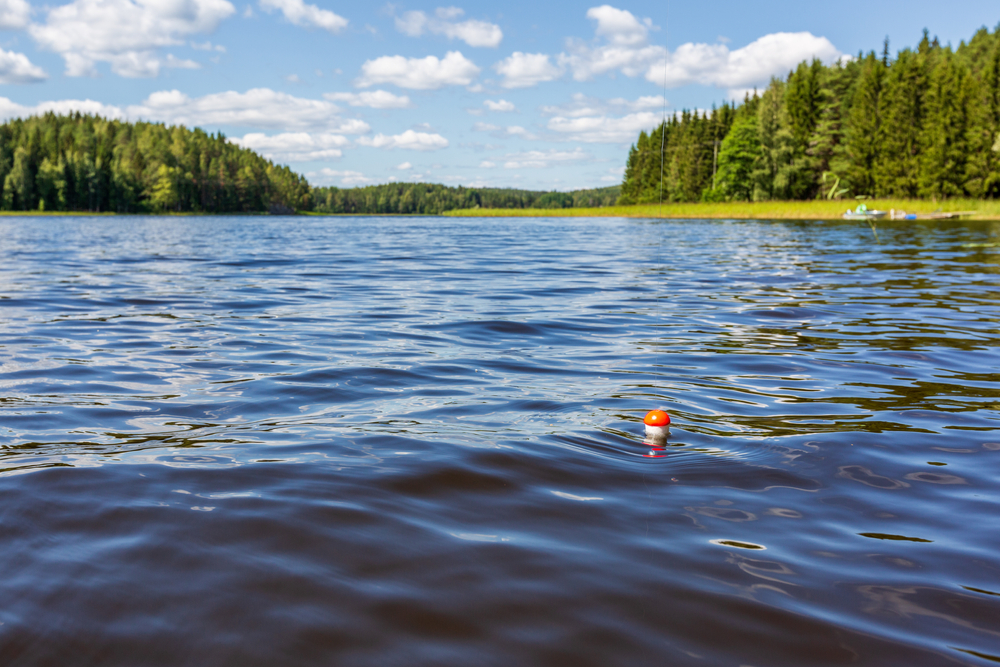
Want to learn how to lake fish for trout? Fishing for trout from a lake shore requires different rigging setups and casting methods than fishing for trout in streams or fast moving waters. Lures and bait are both effective and sinker and bobber rigs are the most commonly used for shore trout fishing.
In this article, we will review all the gear you need for lake fishing for trout, how to step up different trout rigs, what the difference among the rigs are, and how to effectively cast a trout rig from the lake shore.
What Gear Do I Need for Lake Trout Fishing?

The first order of business when learning how to lake fish for trout is having all of the necessary gear. You absolutely need a rod and reel, ideally a spinning reel, as part of your gear kit. You will also need main line and leader line. Make sure your leader line is a lighter test weight than your main line.
Hooks and barrel swivels are your next important pieces of gear. While swivels aren’t completely necessary, they will help keep your line from tangling. Choose your hook size and style according to what is optimal for the species of trout you are looking to catch as well as what is allowed by regulation in the lake in which you are fishing.
If you want to allow for the greatest number of rigging options to try out different setups, make sure you have plenty of bobbers and sinkers. Egg or bullet sinkers tend to work best, and some split shot weights will come in handy as well. Pencil and slip bobbers are the most optimal bobbers to have in your trout fishing kit.
The last thing you need is either bait or lures, or a combination of both. Salmon eggs, power bait, and worms are the best bait for shore fishing. Ideal lures for trout fishing include spoons, crankbaits, and spinners. Always be sure to check what is allowed by regulation when it comes to baits and lures.
What Are the Different Rigs to Use for Lake Fishing for Trout?
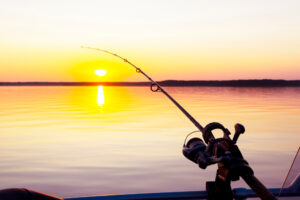
While there are dozens of different trout rigs to use, fixed bobber rigs, slip bobber rigs, and slip sinker rigs are the best choices when fishing for trout from a lake shore.
The advantage of a fixed bobber rig setup is that it is perfect for amateur trout anglers. There are no complicated casting or jigging methods. Once the line is set, you simply have to wait for a hit. This type of setup is perfect for trout that are congregating at a fixed depth, especially near areas with close hiding places like logs on the lake bottom.
The disadvantage of this setup is the requirement of still winds and waters. With too much wind action, your line could get easily tangled.
Slip bobber rigs, on the other hand, allow for variability and control of sinking rates depending on how the fish are biting. This rig is ideal for trout that are hanging out near the bottom of the lake. The disadvantage of the slip bobber rig is that you need to know the depth you’re fishing in order to calculate where to place your sinker on the rig.
The slip sinker rig is one of the most preferred shore casting rigs for trout fishing. The big advantage is that you can reach far into the lake from shore. This setup is also great for trout that linger near the bottom and may not be very close to the shoreline.
One of the biggest disadvantages is that this rig does not have a bobber so you need to be able to feel when a trout hits the line which can be difficult if it is cast far out.
How Do I Set Up a Trout Fishing Rig?
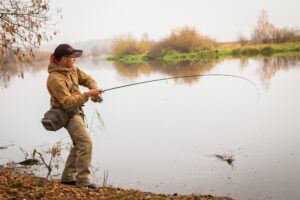
The fixed bobber rig is set up by attaching the end of the main line to the pencil bobber. Using a swivel, connect at least two to five feet of leader line to the main line. At the end of the leader line, the bait hook or lure should be tied on securely with a split shot weight fastened halfway between the hook and swivel.
The slip bobber rig is set up similar to the fixed bobber rig. The difference is there is no split shot between the swivel and hook. Instead, a sinker is placed between the slip bobber and swivel on the main line. Above the slip bobber, a bead and a bobber stop are attached. This allows the bobber to move freely between the sinker and the stop.
The slip sinker rig is perhaps the simplest setup of them all. A sliding sinker is strung through the end of the main line which is attached to a swivel. At least one to three feet of leader line is tied to the other end of the swivel. Attach a baited hook or lure on the end.
How Do I Cast a Trout Fishing Rig from the Lake Shore?

The last thing to learn how to lake fish for trout is knowing how to cast. Fixed bobber rigs should be cast when there is little to no wind. Once the line is out, let it stay stationary until you get a hit. You can slightly jig to get a trout’s attention; however, you may also risk scaring the fish away. Fixed bobber rigs are essentially set and wait casting lines.
Slip bobber rigs require a little more precision and should always be cast when the wind is to your side or at your back. Let the line hit the water and sink to the desired depth. Strikes usually happen fast with this rig so if you don’t feel any hits within a few minutes, it is best to recast.
Slip sinker rigs can be cast far and wide from the shore. Be sure to pick a spot that does not put you in danger of snagging low hanging tree limbs or other anglers. Cast your line as far out as the trout are biting for a good catch.


